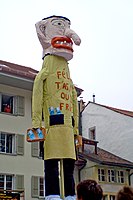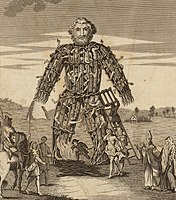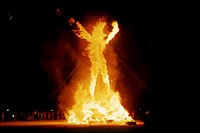Effigy


Aneffigyis a sculptural representation, often life-size, of a specific person or a prototypical figure.[1]The term is mostly used for the makeshift dummies used for symbolic punishment in political protests and for the figures burned in certain traditions around New Year, Carnival and Easter. In European cultures, effigies were used in the past for punishment in formal justice when the perpetrator could not be apprehended, and in popular justice practices of social shaming and exclusion. Additionally, "effigy" is used for certain traditional forms of sculpture, namely tomb effigies, funeral effigies[2]and coin effigies.[3]
There is a large overlap and exchange between the ephemeral forms of effigies.[4]Traditional holiday effigies are often politically charged, for instance, when the generalised figures Año Viejo (the Old Year) orJudasin Latin America are substituted by the effigy of a despised politician. Traditional forms are also borrowed for political protests. In India, for instance, effigies in protests regularly take the form of the ten-headed demon kingRavana,as they figure in the traditionalRamlila.In Mexico and the United Statespiñatasdepicting a politician are sometimes taken to protests and beaten to a pulp.[5]Procedures of formal and popular justice are appropriated when the effigy of a politician in a protest figures in a mock trial, mock execution and mock funeral.
In all cases, except the traditional effigies, there is an emphasis on the social and political aspects of the depicted person. Tomb effigies and funeral effigies exhibit attire and office insignia that indicate social status; coin effigies are signs ofsovereignty;formal punishment of an effigy was synonymous to social death; popular punishment was meant to humiliate and ostracise the depicted; effigies in political protests ridicule and attack the honour of the targeted politician.[6]
Etymology[edit]
The wordefigyis first documented in English in 1539 and comes, perhaps viaFrench,from theLatinsingular formeffigies,[1]meaning "copy, image, likeness, portrait, and statue".[7]This spelling was originally used in English for singular senses: even a single image was "the effigies of...". (This spelling seems to have been later reanalyzed as a plural, creating the singulareffigy.)In effigiewas probably understood as a Latin phrase until the 18th century.[1]The word occurs inShakespeare'sAs You Like Itof 1600 (II, vii, 193), where scansion suggests that the second syllable is to be emphasized, as in the Latin pronunciation (but unlike the modern English pronunciation).
Political effigies[edit]
Hanging or burning the effigy of a political enemy to ridicule and dishonour them is a very old and very widespread practice. It is reported that in 1328, the troops ofHoly Roman Emperor Louis IV,on their campaign in Italy to unseatPope John XXII,burned a straw puppet of the pope.[8]Burning effigies in political protests is especially widespread in India and Pakistan. In the Philippines, the practice came up during the successfulPeople Power Revolutionagainst the regime ofPresident Marcos.Since then effigy protests against the successive presidents developed into elaborate spectacles.[9]USPresident George W. BushandPresident Barack Obamahave been burned in effigy numerous times in protests against military operations and occupations of Afghanistan and Iraq in the countries in the region as well as elsewhere. During theArab Springof 2011 and onward, effigies of the countries' leaders have been hanged in Egypt, Libya, Yemen and Syria.
In the British colonies in New England, effigy performances gained prominence as an effective tool in the protests against the1765 Stamp Act,leading to theAmerican Revolutionand the founding of the United States of America. Afterwards, it became an established form of political expression in US politics, and almost every US President has been burned in effigy at some point in his career.
The best known British example of a political effigy is the figure ofGuy Fawkes,one of the conspirators in theGunpowder Plotwho tried to assassinate KingJames Iin 1605 by blowing up theHouse of Lords.Already a year later, the 5th of November was declared a holiday to celebrate the survival of the king and was celebrated with bonfires. Soon after, effigies of Guy Fawkes were burned. Traditionally, children make effigies from old clothing filled with straw to beg for "a penny for the guy", and communities build their own bonfires. Currently,Lewes,on the south coast of England has the most elaborate celebrations ofGuy Fawkes Night.Competingbonfire societiesmake effigies of important and unpopular figures in current affairs and burn them alongside effigies of Guy Fawkes and thePope.
InPort Said,Egypt, the al-Limby (formerly known as Allenby) is burned during Spring Festival. The tradition started after the First World War, when demonstrators burned an effigy of British High Commissioner for EgyptLord Allenbyduring a protest against the presence of British troops in the city.[10]In the second half of the 20th century it became custom to portray contemporary enemies of Egypt as the al-Limby. During the Arab Spring, effigies of President Mubarak and other Egyptian politicians were exhibited and burned as the al-Limby.[11]
Traditional effigies[edit]
Burning effigies is part of many rituals to mark the change of the seasons, performed all over Europe in locally distinct traditions. The figures usually personify adverse forces of life (winter, the old year, the witch,Judas Iscariot) and their burning marks and celebrates the annual cycle of life—death and rebirth, the defeat of winter and the return of spring. Most traditions are staged around New Year, at the end of Carnival or in the week before Easter.
Many of these traditions have been exported by migrating people to other countries. European settlers brought their traditions to the colonies, where they might have merged with local traditions. In countries of Latin America, the Spanish tradition of burningAño Viejo(the Old Year) on New Year Eve andJudason Good Friday is widely practiced. Judas is also burned in the Philippines. The tradition of burningGuy Fawkeshas been brought to New England, Canada, Australia, New Zealand and other British colonies. The Indian and Pakistani tradition of burningRavanais also practiced in Trinidad and in Edinburgh and Manchester, UK. In the 1970s German students established the burning of Winter in the form of a snowman at Lake Superior State University in Michigan, US.
TheMarzannaritual represents the end of the dark days of winter, the victory over death, and the welcoming of the spring rebirth. Marzanna is aSlavic goddessof death, associated with winter. The rite involves burning a female straw effigy or drowning it in a river, or both. It is a folk custom in Poland, Slovakia and the Czech Republic, taking place on the day of thevernal equinox.
Funeral effigies[edit]
Funeral effigies made from wood, cloth and wax played a role in the royal funeral rituals in early modern France and England.[12]Following the medieval European doctrine of the double body of the king, these effigies represented the immortal and divine kingship.[13]The effigy was dressed in the royal regalia and waited upon as if alive, while the monarch's physical remains remained hidden in the coffin. After the coronation of the new king, these effigies were stored away. The museum ofWestminster Abbeyhas a collection of English royal wax effigies reaching back toEdward III of England,who died in 1377. In the 18th century also other important personalities were honoured with a funeral effigy, for instance British prime ministerPitt the Elder,the naval heroHoratio Nelson,French emperor Napoleon, andFrances Stewart, Duchess of Richmond,who also had her parrot stuffed and displayed at her own request and expense.[citation needed]
From the time of the funeral ofCharles IIin 1685, effigies were no longer placed on the coffin but were still made for later display.[14]The effigy of Charles II was displayed over his tomb until the early 19th century, when all effigies were removed from the abbey.[citation needed]Nelson's effigy was a tourist attraction, commissioned the year after his death and his burial inSt Paul's Cathedralin 1805. The government had decided that major public figures withState funeralsshould in future be buried at St Paul's. Concerned for their revenue from visitors, the Abbey decided it needed a rival attraction for admirers of Nelson.[15]
Tomb effigies[edit]

Atomb effigy,in Frenchgisant ( "recumbent" )is the usually life-size sculpted figure depicting the deceased on atomb monument.Although thesefunearyand commemorativereliefswere first developed inAncient EgyptianandEtruscancultures, they appear most numerously in Western Europe tombs from the later 11th century, in a style that continued in use through theRenaissanceandearly modern period,and are still sometimes used. They typically represent the deceased in a state of "eternal repose", with hands folded in prayer, lying on a pillow, awaiting resurrection with a dog or lion at their feet. A husband and wife may be depicted lying side by side.[16]
A related type of tomb effigy, thecadaver monument,shows the corpse in a state of decomposition as a reminder of human mortality.[17]
Other types[edit]
In the field ofnumismatics,effigy describes the portrait on theobverseof a coin.[18][19]A practice evident in reference literature of the 19th century,[20]the obverse of a coin was said to depict "the ruler's effigy".[21]The appearance and style of effigy used varies according to the preference of the monarch or ruler being depicted - for example, some, such asGeorge VIof theUnited Kingdomhave preferred to be shown uncrowned, while others have favoured highly-formal representations. It can also be the case that the monarch's reign becomes long enough to merit issuing a succession of effigies so that their appearance continues to be current. Such has been the case forQueen Victoria(three effigies over 63 years) andElizabeth II,who was depicted by five different effigies on British coins and three different effigies on Britishpostage stampsbetween her ascension to the throne in 1953 and her death in 2022.
Effigy moundis a term used in thearchaeologyof (mainly)Pre-Columbian Americafor a large earthwork in the shape of a stylized animal, symbol, human, or other figure and generally containing one or more human burials.
Effigy vesselis a term used in the archeology of (mainly) Pre-Columbian America for ceramic or stone containers, pots, vases, cups, etc., in the shape of an animal or human.
In the past, criminalssentenced to deathin absentiamight be officially executed "in effigy" as a symbolic act. In southern India, effigies of the demon-kingRavanafrom theepic poemtheRamayanaare traditionally burnt during the festival ofNavrati.
Awicker manwas a large human-shapedwickerstatue allegedly used inCeltic paganismforhuman sacrificeby burning it, when loaded with captives.
-
The funeral effigy (without clothes) ofElizabeth of York,mother ofKing Henry VIII,1503,Westminster Abbey
-
A rare wax funerary effigy of a private person, who stipulated it be made in her will, England, 1744. Holy Trinity Church,Stow Bardolph,Norfolk.
-
"Grand Rababou"(from the French wordrababouêt,or wood thief) is burnt annually in thecarnivalofFribourg, Switzerland
-
ModernMarzanna(goddess) effigy, Poland
-
An 18th-century engraving of a Celticwicker man,ready for burning
-
Welshchildren with theirGuy Fawkeseffigy in November 1962. The sign reads "Penny for the Guy".
-
Every year The Man is burned at theBurning Manfestival, Nevada
See also[edit]
References[edit]
- ^abc"effigy, n.".Oxford English Dictionary(Online ed.).Oxford University Press.(Subscription orparticipating institution membershiprequired.)
- ^pixeltocode.uk, PixelToCode."Funeral and wax effigies".Westminster Abbey.Retrieved2024-05-17.
- ^"Why does the monarch's effigy appear on coins?".perthmint.Retrieved2024-05-17.
- ^Florian Göttke, "Burning Images: Performing Effigies as Political Protest", (PhD dissertation, University of Amsterdam, 2019), 54–55.
- ^Semko, Elizabeth (Apr 26, 2016)."Cherokee Street's Giant Trump Pinata Will Help Release Your Political Frustrations".Riverfront Times.Archived fromthe originalon Aug 18, 2021.
- ^Florian Göttke, Burning Images: Performing Effigies as Political Protest, (PhD dissertation, University of Amsterdam, 2019), 39–40.
- ^Latdict, s.v. "effigies",http:// latin-dictionary.net/search/latin/effigies
- ^Wolfgang Brückner,Bildnis und Brauch: Studien zur Bildfunktion der Effigies(Berlin: Erich Schmidt Verlag, 1966), 197–201.
- ^Florian Göttke, "Burning Images for Punishment and Change",Trigger,Fotomuseum Antwerpen, BE, November 2019.
- ^Mériam N. Belli,An Incurable Past: Nasser's Egypt Then and Now(Gainesville: University Press of Florida, 2013), 75–162.
- ^Trevor Mostyn, "Will militant Islam hijack Egypt’s beautiful revolution?", weblog Planetary Movement, April 21, 2011,http:// planetarymovement.org/index.php?option=com_content&task=view&id=536&Itemid=61[dead link]
- ^Ernst H. Kantorowicz,The King's Two Bodies: A Study in Mediaeval Political Theology(Princeton: Princeton University Press, 1957), 419–37.
- ^Ernst H. Kantorowicz,The King's Two Bodies: A Study in Mediaeval Political Theology(Princeton: Princeton University Press, 1957), 382–84.
- ^"Westminster Abbey, Royal funerals".Archived fromthe originalon 2014-07-14.Retrieved2013-11-10.
- ^Westminster Abbey, "Horatio, Viscount Nelson".
- ^Fozi (2021), pp. 12, 13, 58
- ^Bass (2017), p. 163
- ^Cuhaj, George S. (2012).2012 Standard Catalog of World Coins - 1901-2000(39 ed.). Krause Publications. pp.333,968, 991, 1523, and 1966.ISBN978-1-4402-1572-8.
- ^Cuhaj, George S. (2013).2014 Standard Catalog of World Coins, 2001-Date(8 ed.). Krause Publications. pp. 152, 177, 179, 191, 225, and 655.ISBN978-1-4402-3568-9.[permanent dead link]
- ^The Encyclopædia Britannica: A Dictionary of Arts, Sciences, and General Literature.Vol. 17 (9 ed.). The Henry G. Allen Company. 1890. p. 630.ISBN9781276858373.
- ^Hilsdale, Cecily J. (2014).Byzantine Art and Diplomacy in an Age of Decline.Cambridge University Press. p. 169.ISBN978-1-107-03330-6.
Sources[edit]
- Bass, Marisa Anne. "The transi tomb and the genius of sixteenth century Netherlandish funerary sculpture".Netherlands Yearbook for the History of Art,volume 67, 2017.JSTOR26593102
- Fozi, Shirin.Romanesque Tomb Effigies: Death and Redemption in Medieval Europe, 1000–1200.University Park (PA): Penn State University Press, 2021.ISBN978-0-2710-8917-1








